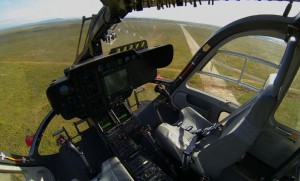Eurocopter has flown an “optionally piloted vehicle” (OPV) – an EC145 – in a validation flight that included deployment of an external sling load and undertaking a representative observation mission.
Following the success of the flight, Eurocopter will now pursue OPV flight capabilities for its product line of light, medium and heavy-lift helicopters – enabling them to be flown by pilots or in an unmanned mode.
“This latest achievement results from our company’s expertise in flight control and autopilot systems, human-machine interface, system architecture and integration,” Eurocopter chief technical officer Jean-Brice Dumont said about the validation.
The flight used a four-dimensional flightplan that was uploaded to the helicopter. After an automatic takeoff, the EC145 flew the circuit via multiple pre-programmed waypoints, during which it performed a mid-route hover to deploy a load from the external sling. The EC145 continued on a return route segment representing a typical observation mission, followed by an automatic landing.
For delivery of the external load, the helicopter entered a planned hover – enabling the ground station controller to provide flight control inputs in orienting the EC145 over the drop point. The ground controller then transmitted a command to release load once the helicopter and load were correctly positioned.
 Visibility during the EC145’s unmanned flights was provided to the ground station via onboard cameras. They were complemented by an external gimballed camera on the helicopter for infrared and daylight mission imaging.
Visibility during the EC145’s unmanned flights was provided to the ground station via onboard cameras. They were complemented by an external gimballed camera on the helicopter for infrared and daylight mission imaging.
















James from Sydney
says:I’m trying to figure out what the point of this is. Is it for military use? If so, to deliver goods (weapons)?
Josh
says:The limitations of this are vast. The entire flight had to be pre-programmed, and then controlled remotely; meaning ‘see and avoid’ compliance with VFR and flexibility is not possible. With regard to situational awareness a UAV is like looking at the world through a drinking straw. It also sucks up a lot of bandwidth for basic commands, denying that bandwidth to other users ( a big problem in combat) and leaving the door open to jamming and interference. It’s still very hard to beat the value-add of a human, in-vehicle pilot.
Maurice Dee
says:This achievement takes me back to 1959 when I was asked to do a design study on a pilot-less chopper. It was a deliberate attempt to reduce the cost of aerial crop-dusting/spraying in the confines of European agriculture.
By using a flatbed truck as its base it could be driven to the edge of a field and then flown by an operator situated in the field to be worked. A limited amount of fuel could be readily topped up from the truck as could the product to be delivered. This, together with the lack of on-board pilot kept the weight to a minimum. Since there would be no need to ever fly over populated areas, it was envisaged that a less stringent Air Worthiness Certificate would also contribute to cost reduction. That was 54 years ago – progress is slow!